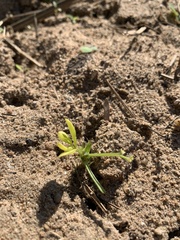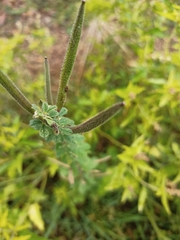Cleome viscosa: taxon details and analytics
- Domain
- Kingdom
- Plantae
- Phylum
- Tracheophyta
- Class
- Magnoliopsida
- Order
- Brassicales
- Family
- Cleomaceae
- Genus
- Cleome
- Species
- Cleome viscosa
- Scientific Name
- Cleome viscosa
Summary description from Wikipedia:
Cleome viscosa
Cleome viscosa, the Asian spiderflower or tick weed is an annual herb that grows up to a meter high. It belongs to the family Cleomaceae. It is considered an invasive species and is widely distributed in warm and humid habitats across the Americas, Africa and Asia, and in Australia (where it is considered a native). It is commonly found during the rainy season.
The crushed leaves have been investigated as a treatment for stored seeds of cowpea, to prevent weevil infestation.
The leaves are used as external application to wounds and ulcers. The seeds are anthelmintic and carminative. The juice of the leaves is used as a remedy against discharge of pus from the ear. In a study comparing C. viscosa to standard antibiotics, it was proven to be effective at inhibiting microbial growth. This demonstrates its effectiveness as an antimicrobial agent in comparison to the antibiotic tetracycline.
In northern India, the seeds (called Jakhya) are used as a culinary herb, mainly for tempering. in Australia, the Walmajarri people of the southern Kimberley call it Jirlpirringarni.
...Cleome viscosa in languages:
- Chinese
- 黃花草
- Chinese
- 向天黃
- English
- Asian spiderflower
- English
- mustard bush
- English
- tickweed
- English
- dog mustard
- Japanese
- キバナフウチョウソウ
- Russian
- Клеоме клейкая
- Thai
- ผักเสี้ยนผี
Images from inaturalist.org observations:
We recommend you sign up for this excellent, free service.
Parent Taxon
Sibling Taxa
- Cleome aculeata
- Cleome africana
- Cleome allamanii
- Cleome amblyocarpa
- Cleome angulata
- Cleome angustifolia
- Cleome anomala
- Cleome arabica
- Cleome arborea
- Cleome aspera
- Cleome augustinensis
- Cleome austroarabica
- Cleome boliviensis
- Cleome bororensis
- Cleome brachycarpa
- Cleome carnosa
- Cleome chelidonii
- Cleome chilensis
- Cleome chrysantha
- Cleome circassica
- Cleome cleomoides
- Cleome coluteoides
- Cleome conrathii
- Cleome daghestanica
- Cleome dendroidea
- Cleome diffusa
- Cleome dolichostyla
- Cleome droserifolia
- Cleome dumosa
- Cleome elegantissima
- Cleome felina
- Cleome foliosa
- Cleome formosa
- Cleome fosteriana
- Cleome gigantea
- Cleome glandulosa
- Cleome glaucescens
- Cleome grandidieri
- Cleome guaranitica
- Cleome guianensis
- Cleome gynandra
- Cleome hanburyana
- Cleome hemsleyana
- Cleome heptaphylla
- Cleome hirta
- Cleome houtteana
- Cleome humilis
- Cleome iberica
- Cleome iberidella
- Cleome insolata
- Cleome kalachariensis
- Cleome laburnifolia
- Cleome lechleri
- Cleome limoneolens
- Cleome longifolia
- Cleome longipes
- Cleome macrophylla
- Cleome maculata
- Cleome magnifica
- Cleome melanosperma
- Cleome microaustralica
- Cleome monophylla
- Cleome moritziana
- Cleome noeana
- Cleome ornithopodioides
- Cleome oxyphylla
- Cleome paludosa
- Cleome paradoxa
- Cleome parviflora
- Cleome parvisepala
- Cleome paxii
- Cleome pilosa
- Cleome procumbens
- Cleome quinquenervia
- Cleome rosea
- Cleome rubella
- Cleome rupicola
- Cleome rutidosperma
- Cleome scaposa
- Cleome schlechteri
- Cleome semitetrandra
- Cleome serrata
- Cleome simplicifolia
- Cleome socotrana
- Cleome speciosa
- Cleome spinosa
- Cleome stenophylla
- Cleome strigosa
- Cleome suffruticosa
- Cleome tenella
- Cleome tenuis
- Cleome tetrandra
- Cleome titubans
- Cleome trachycarpa
- Cleome uncifera
- Cleome usambarica
- Cleome violacea
- Cleome viridiflora
- Cleome viscosa
- Corynandra chelidonii































































































































































